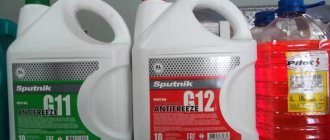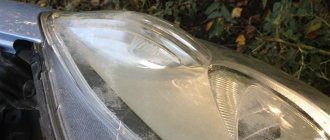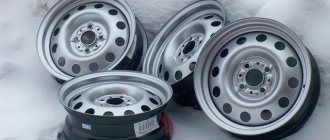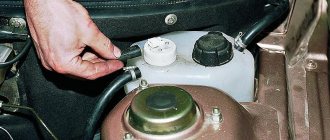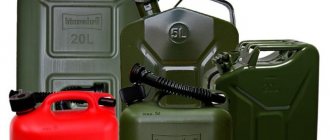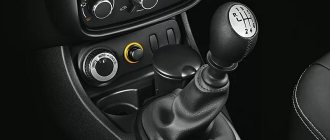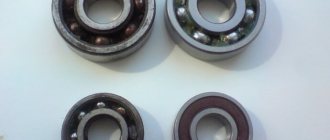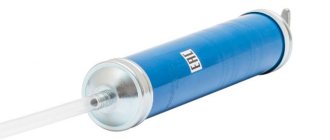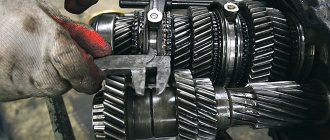Purpose of the cooling system
The engine in a car gets seriously hot during operation, and without an effective cooling system, the driver would have to stop every 10 minutes, which would reduce the operating temperature of the oil and the engine itself. It is the presence of a cooling system that allows the power unit to operate under extreme loads. Inside the engine, liquid is forced to circulate through special channels, which is subsequently sent to the radiator, where it is quickly cooled and again supplied to the engine.
The effectiveness of such cooling of the power unit will depend on the efficiency of all elements of the system, as well as on the use of high-quality antifreeze, which retains its performance characteristics for a long time.
In modern engines, the entire operation of the cooling system is fully controlled automatically. Electric thermostats and pumps are used here, and the fan on the radiator is turned on by command from sensors and the main engine control unit.
Antifreeze or antifreeze for VAZ-2109 and other models
Now let's look at this situation on more modern cars. So, what is better - Antifreeze or antifreeze for the VAZ 2109. Similar questions can also be included here: VAZ-2114 - Antifreeze or antifreeze, VAZ 2115 - Antifreeze or antifreeze.
Related link:
How to choose winter tires for a VAZ
The situation with these cars is similar to the VAZ-2107 model. That is, antifreeze is standard for these cars, but it is also possible to use antifreeze, but only of certain brands.
Replacing fluid on a VAZ-2110
As for the replacement procedure, let's look at how to replace Antifreeze with VAZ-2110 antifreeze or vice versa:
- The car is installed on the platform and cooled;
- The expansion tank cap is removed, the heater tap is opened, the plugs on the radiator and crankcase are unscrewed, and the waste fluid is drained into a container;
- The plugs are installed in place and flushing liquid or distillate is poured into the system. The engine starts to circulate the fluid;
- The flushing fluid is drained, and then fresh antifreeze or antifreeze is added;
On other specified models, the operation is performed similarly.
And as a result, we note that antifreeze is still better than Antifreeze in its properties, but it also costs more. If you want to take better care of your car, then you should fill it with antifreeze, but only of the appropriate brand. But a feature of our automobile industry is the possibility of system leakage, and replenishing the level of antifreeze can be expensive.
Antifreeze also does a good job, but it needs to be changed more often, but it costs less.
History of creation
Initially, car owners used ordinary water as a coolant in internal combustion engines, which made it possible to effectively cool the operating power unit. However, such water froze when the first cold weather set in, and scale of calcium and salt deposits formed inside the engine and in the radiator, which led to the need for expensive engine repairs.
In the 50s of the last century, with the development of the automotive industry in the USSR, the need arose to develop a high-quality coolant that would not freeze at temperatures of the order of minus 35 degrees, retain all its properties, be flexible and at the same time not contain any deposits that could precipitate at significant temperatures. increasing temperature inside the engine.
The development of antifreeze was carried out at the Institute of Organic Synthesis Technology, from the abbreviation of which this coolant was named. Subsequently, the abbreviation antifreeze remained unchanged, and the use of various additives and chemical compounds made it possible to significantly improve the performance characteristics, which are maintained throughout the entire service life of this technical fluid.
Chemical composition and properties
The coolant is based on salts of inorganic origin, which tend to form a film on the metal surfaces of the engine, protecting the power unit from the effects of ethylene glycol and preventing metal corrosion. Modern antifreeze is made with glycol ether and monoethylene glycol, is transparent and has a density of 1.112 g per cubic centimeter. The boiling point is 197 degrees Celsius, which is sufficient for use in most standard internal combustion engines.
Antifreeze contains distilled water, which makes the liquid less viscous. If necessary, car owners can independently add a small amount of distillate, adjusting the density of the composition, which allows them to reduce the cost of purchasing high-quality original antifreeze.
The presence of ethylene and propylene glycol allows the liquid to maintain its original state and prevents it from freezing at low temperatures. Propylene glycol has a pungent odor, but this chemical is a common derivative of alcohol and is completely safe for both humans and the engine.
The popularity of this type of coolant is largely due to its versatility of use and numerous advantages . These advantages include the following:
- Does not freeze at extremely low temperatures.
- Does not boil over a wide temperature range.
- Does not ignite.
- Has low viscosity.
- It is characterized by heat capacity and high thermal conductivity.
- Chemical stability during storage and operation.
- Does not cause corrosion of the engine and cooling system.
- Doesn't foam.
Antifreeze has practically no disadvantages. It has an affordable price, especially compared to other branded antifreezes, which are recommended for use on various foreign cars. The car owner will only need to take care of the timely replacement of technical fluids, which after 50 thousand km or 3 years of operation may lose their characteristics, not providing high-quality engine cooling.
Many car owners are confident that the performance characteristics and the specific type of antifreeze depend on the color of the liquid.
However, in reality, the standard formula is colorless, and to prevent mixing of compositions with different characteristics, manufacturers add dyes, which somewhat simplifies the selection and subsequent use of antifreeze.
In auto accessories and spare parts stores you can find various types of antifreeze and antifreeze. There is no significant difference between these coolants. They have virtually the same freezing point and can be made on a similar basis. The difference between foreign antifreezes and domestic antifreezes is only in the additives and additives used. However, such coolants should not be mixed with each other , since the additives contained may come into contact with each other, which leads to sedimentation.
What is the difference between Antifreeze and other antifreezes, classification
Antifreeze is a first generation antifreeze with a minimum of additives and it differs from modern compounds, like Zhiguli from Tesla. Antifreeze is a cheap and low-quality antifreeze without lubricating, antifoaming, cleaning and other additives that are found in any other antifreeze. Most often, Antifreeze is blue-tinted water with a minimal amount of ethylene glycol, and its use on modern cars cannot be justified even by its meager price and availability on any car market in any quantity. Most often, even sellers have no idea about the composition of Antifreeze; the liquid can be made on the basis of any antifreeze (carboxylate, silicate), which the label does not even mention.
Antifreeze, unlike antifreeze, contains various additives.
Modern antifreezes differ from each other only in composition and not in color.
Color is not an additive, it is just a dye and has nothing to do with the composition of the liquid.
Now briefly about the classification of modern antifreezes.
Antifreeze G11
G11 - green antifreeze.
If we get our hands on a canister marked G11 , we can be sure that it is antifreeze based on silicates and with a small amount of inorganic additives. In other words, this is an analogue of that very ancient Antifreeze. The main disadvantage of such antifreezes is the protective film that they create over the entire area of the cooling system. Over time, the film reduces the heat transfer of the engine, and it may cool worse. Such compositions boil already at 105 degrees, and they need to be replaced every 1.5–2 years . As a rule, they are used in large-volume engines on cars produced before 94-95. Inexpensive, it can last 40-50 thousand kilometers tolerably, but it needs to be replaced as often as possible.
Antifreeze G12 and G12+
G12 - red antifreeze.
The next generation of carboxylate-based antifreezes. The principle of operation of the composition is radically different from G11 . It does not create films, does not clog the system, and removes pockets of corrosion thanks to additives. They have a full range of anti-foam, lubricating and cleaning additives, excellent thermal conductivity and a five-year service life. The same can be said about G12+ antifreeze , this is a more advanced version of carboxylate compounds.
Antifreeze G13
G13 - purple antifreeze.
One of the latest generations of propylene glycol-based compounds. It has excellent thermal conductivity, long service life and low toxicity . Used in highly loaded forced modern engines. The composition includes the most modern additives for caring for the cooling system.
Types of antifreeze
Car owners can purchase both a concentrate, which will require subsequent dilution of the distillate, and liquids that are completely ready for use. From the antifreeze labeling you can obtain information about the freezing temperature, as well as the presence of a modernized formula that prevents the formation of corrosion and calcium deposits inside the engine.
Initially, buyers were offered only two classes of antifreeze:
- A-40.
- A-65.
However, subsequently, improved versions of the coolant were developed, which in their characteristics are not inferior to expensive antifreezes. Antifreeze, the decoding of which is not particularly difficult, may have different symbols. The presence of the M index in the name indicates a modernized formula and the use of various corrosion inhibitor additives, which make the use of such technical fluids completely safe for modern cars.
When operating a car in central Russia, where winter temperatures rarely drop below minus 30 degrees, standard antifreeze will be sufficient, which freezes at temperatures below 45 degrees. But in the north, where truly extreme frosts can occur, car owners prefer the A 65 M modification, which is able to maintain its performance characteristics over a wide temperature range.
Most car owners, in order to save money, purchase concentrates and dilute them with distilled water themselves, which can significantly reduce the cost of car servicing. To obtain coolant with a freezing point of -40 degrees, the concentrate is diluted with distilled water in a one-to-one ratio. If you need a solution with a freezing point of -30, then mix 3 parts water and 2 parts concentrate.
It is necessary to dilute concentrated antifreeze in a separate container and only then pour coolant into the expansion tank or radiator. You should not use ordinary tap water to dilute the concentrate, since antifreeze and the components it contains can separate when in contact with hard water, which contains magnesium and calcium salts. Only distilled water will provide a 100% guarantee against sediment formation.
Replacing fluid on a VAZ-2107
Carrying out all the work on this car is not that difficult. Tools you will need:
- Key to 13;
- Key for 30 (possibly);
- Screwdriver;
- Drain container;
You should also take care of purchasing new fluid. In this car, its quantity in the system should be 8.65 liters.
The work is carried out in the following order:
- The car is placed on the platform and time is given to cool down (if the engine is warm);
- Remove the caps from the radiator filler neck and expansion tank. Also in the cabin, on the heater control panel, we move the lever to heating, thereby opening the heater radiator tap;
- Unscrew the drain plug at the bottom of the radiator. On older models there is no such plug, so on them the temperature sensor is unscrewed with a 30 key. There is also a drain plug on the engine, which we also remove. We collect the leaking liquid into a prepared container;
- After draining, install all plugs in place;
- We wash the system. To do this, distilled water or a special detergent is poured into it. In order to completely fill the system and displace the air, remove the pipe going to the intake manifold. As soon as water or liquid comes out of it, we put it in place;
- We start the engine so that it flushes the system through circulation;
- Drain the water through the plugs. Fill in new coolant. We start the motor for circulation. Then we are interested in the amount of liquid in the system and, if necessary, add it to the expansion tank to the required level.
Recommendations for selection
Today you can find dozens of different types of coolant in specialized stores. Such diversity significantly complicates the choice of car owners who cannot figure out what kind of antifreeze there is. When choosing, you should know why antifreeze is needed in the car and pay attention to the following indicators:
- Freezing temperature.
- Color.
- Taste and smell.
- Label.
- Tara.
Freezing temperature indicators will depend on the density of the liquid, as well as the mass fraction of propylene glycol content in it. The cost of antifreeze directly depends on its freezing point, so by making the right choice, you can save a lot. The golden mean will be the coolant, whose freezing point is at 30-40 degrees. This antifreeze will be sufficient for use on cars in central Russia.
The color of the liquid has no bearing on the characteristics or physical properties of the product. Most experts recommend giving preference to colored antifreezes, while mixing coolant of the same color in the engine is allowed.
High-quality antifreeze will have a pronounced sweetish odor. But you should not taste the coolant, since it is a toxic substance, and a small amount of methylethylene glycol entering the body can lead to poisoning.
A well-made branded antifreeze will have a label indicating the product markings, as well as all its technical characteristics. It’s still not worth purchasing antifreeze, the canister of which has a label of unknown origin. With a high degree of probability, this is not a very high-quality product, the use of which can only harm the car engine.
How to choose and how often to change
Today you can find different types of coolant in car stores. Many drivers begin to get lost and do not know which product to choose and how to choose the right antifreeze.
We suggest that you first pay attention to the following aspects:
- On the product label;
- Quality of packaging;
- Coolant freezing point;
- The smell and color of antifreeze.
During operation, the coolant is subject to sudden temperature changes, and after some time, replacement may be required for quality cooling. If we take the time period into account, it is recommended to completely replace the antifreeze after two to three years of active use of the car. If you take mileage into account, it is recommended to replace it every 50-60 thousand kilometers.
To carry out a fluid change, no special knowledge or skills are required and can be done independently by any driver. If you do not know how to replace antifreeze in the radiator and cooling system, we recommend contacting specialized centers and entrusting the work to specialists. You can purchase the necessary antifreeze yourself or entrust the choice to the service workers.
Proper car service
During operation of the machine, it will always be necessary to replace the coolant. It is recommended to perform such work every 2-3 years or after 50-70 thousand kilometers. Experts recommend performing a complete fluid change, when the antifreeze is drained not only from the expansion tank and radiator, but also from the jacket in the engine. Antifreeze is poured into the radiator and expansion tank, the system is pumped and ventilated.
Replacing coolant in most modern cars is not difficult, so every driver can do this job. The car owner only needs to know how antifreeze stands for, and depending on this, make the right choice. It is necessary to use only high-quality antifreeze , and when the first problems appear in the operation of the cooling system, a complete engine diagnostics should be performed, which will prevent engine overheating.
Antifreeze or antifreeze for VAZ-2107
Let's consider all the nuances on specific models. First, let's figure out what is better for the VAZ-2107 - Antifreeze or antifreeze. The main fluid for this car is the same Antifreeze 40 or Antifreeze 65. But it is also possible to use antifreeze. Moreover, there is no difference in the power system - whether it is injection or carburetor.
And here lies the rub. If a decision is made to pour antifreeze into the system, then it must be selected strictly according to the manufacturer’s recommendations. The use of inappropriate antifreeze can lead to destruction of pipes and system elements, since additives can be aggressive to them.
It should be noted that antifreeze and antifreeze are incompatible with each other. An attempt to mix them often leads to the formation of reaction products of additives in the liquid, which can easily clog channels of small cross-section.
Therefore, if the owner does not know exactly what was poured into the system, then before changing the fluid it is better to flush the system with at least distilled water, and then fill the VAZ-2107 with antifreeze or antifreeze injector.
Related link:
How to install a power switch on a VAZ
